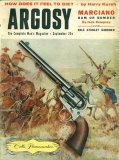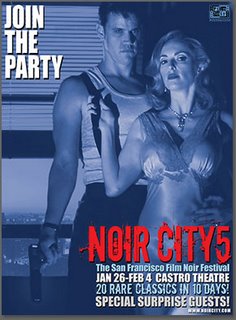 A Crime Novel in Installments,
A Crime Novel in Installments,
by Dick AdlerThe high desert wind sliced through their city clothes. Up ahead was the virtually deserted town of Los Alamos, where they hoped the man they had come for was still alive. Then a row of very bright lights burst into life, followed by another. Men with guns, wearing watch caps and heavy gloves, exploded out of Quonset huts. The guns were all pointing at them ...
* * *
It began with a poker game.
They had hired a boozed-out magazine writer named
Jim Thompson with a couple of pulp crime novels to his credit as managing editor of
Saga downstairs. Thompson lasted about six months; he eventually got fired for trying to start a union of writers and editors, and moved on to the same job on the less-demanding
Police Gazette.Meanwhile, people like Ivan Davis, who worked a few floors above for Worldwide Publications--including a men’s adventure magazine called
Viking, for which he toiled as articles editor for $150 a week--served under a burly ex-Marine named Morgan McLennon, a managing editor who hid beneath his rough exterior a surprising streak of sensitivity and intelligence. He’d spent a year in Paris, where he became friendly with
Brendan Behan, and was a champion freeloader of food and travel. He was also a deadly gin rummy player, and more often than not took lunch money from Ivan while Davis cursed and kicked his filing cabinet.
Neither Thompson nor McLennon played in the Friday night poker games--Morgan because he had a socially demanding wife, and Thompson because he sent his money back to Los Angeles, where his family lived. It was a colorful group--mostly men’s adventure magazine writers and editors whose hopes for literary fame and fortune surged with every week’s
New York Times Book Review.Although Worldwide employees and the gang from
Saga made up its core, a sizable band of would-be tough-guy types also took the weekly after-work journey from Magazine Management to the building on the corner of Third Avenue, across 42nd Street from the
Daily News with its giant golden globe in the lobby, and just down the street from Tim Costello’s famous bar and restaurant.
The assembly this Friday included Barry Sternberg and Dick Harris, the two top editors of
Sport; Saga’s suave and ambitious art director, Hal Goldman; three would-be novelists from
Male and
Stag--Bruce Pronzini, Billy Freeman, and Josh Green; plus Ivan’s friend and new housemate,
Viking’s fiction editor, Ross Calhoun. And of course Davis, nothing like as good a poker player as he thought he’d become in the hills of Korea.
The telephone at the receptionist’s desk had been ringing all evening; now it went off every five minutes. Finally, Dick Harris, having already won his tiresomely predictable $75, folded an unpromising hand and got up to answer it.
“Maybe you’d better take this,” he said to Ivan when he came back to the three desks they’d pushed together to make their table. “He says he’s one of your writers--Saul Cooperman?”
Cooperman was the author of a prize-winning novel from the 1930s,
An Immigrant’s Diary--a book that Ivan’s freethinking (on almost all other subjects) socialist father had objected to his son bringing home, because of its sex scenes. So Davis read it with awe and jealousy in the library at James Monroe High School, and he began to think about writing for a living.
Drink and a vanishing talent for fiction had reduced Cooperman: he now wrote true-crime stories for the men’s adventure magazines. Most of his work for
Viking involved research for the Court of Final Justice, publisher Louis Erickson’s attempt to add class to his sleazy product by assembling a team of experts to solve famous crimes.
“Saul, what’s up?” Ivan asked, after deciding that his chances of drawing to a flush were slim.
“Ivan , I need to reach Morgan,” Cooperman answered in his boozy but still oddly impressive voice. “I’ve got a great lead into this story I’m working on, but I’ll need some dough to make my contact.”
“How much are we talking about here?”
“Five hundred should cover it. Can Morgan get me that much as soon as possible?”
Erickson was a notorious penny-pincher who once said to Davis, after he told him that one of their top writers--who had two stories unpaid for and a wife dying of cancer--was begging for a check, “Pay him for one.” So the chances of McLennon getting Erickson to lay out that kind of cash in a hurry were nonexistent.
“I can’t reach Morgan until tomorrow,” Ivan lied. “What story is this--the Lopez murder?”
“That’s it. I’ve got a source, a guy in Santa Fe who says he knows what really happened. But he won’t hang around waiting: you guys have to move on this right away.”
“I’ll do what I can,” Ivan told him. Noticing that a new hand was being dealt, he hung up and returned to the table.
An hour later, he was down to two bucks in his wallet, plus his uncashed paycheck. They decided to call it a night. For a moment Ivan blanked out and thought about going home on the IRT to the West Bronx, where until two months ago he’d been living in his old bedroom in his parents’ railroad apartment in Castle Hill. Then he remembered he was now a Manhattan guy, renting (for $30 a week) a one-bedroom place in the house on East 82nd, where Ross Calhoun also lived. Owned by a rich old widow and furnished in dusty 1930s plush grandeur, it was close to the Metropolitan Museum, where artistic young women seemed impressed by Ivan’s job. These, plus the stewardesses he met on the flights that Morgan’s heavy freeloading schedule made him pass down reluctantly to Ivan, added up to a sex life which was definitely occasional but often interesting.
“I was going to suggest a beer at Costello’s,” Ivan said to Ross. “But then I’d have to borrow subway money from you, plus twenty bucks for the weekend.” They walked out onto 42nd Street, nearly deserted at midnight, and headed for the subway on Lexington.
* * *
STAY TUNED: Next Monday, find out what happened to Saul Cooperman, and what Ivan and Ross do about it--after they give their sex drives a workout with the help of a female peacenik, some Smith graduates, and the odd stewardess.© Copyright 2007 by Dick Adler
 a lengthy interview with Morris (who has also written a previous novel, Taking Comfort, as “Roger Morris”) and a review of his new book.
a lengthy interview with Morris (who has also written a previous novel, Taking Comfort, as “Roger Morris”) and a review of his new book.








 As regular readers of this blog know, I’m a huge fan of older TV detective series. And, much to my wife’s consternation, I have been buying up DVD versions of those productions as they can be found. But I thought I already had all the episodes of
As regular readers of this blog know, I’m a huge fan of older TV detective series. And, much to my wife’s consternation, I have been buying up DVD versions of those productions as they can be found. But I thought I already had all the episodes of 




















